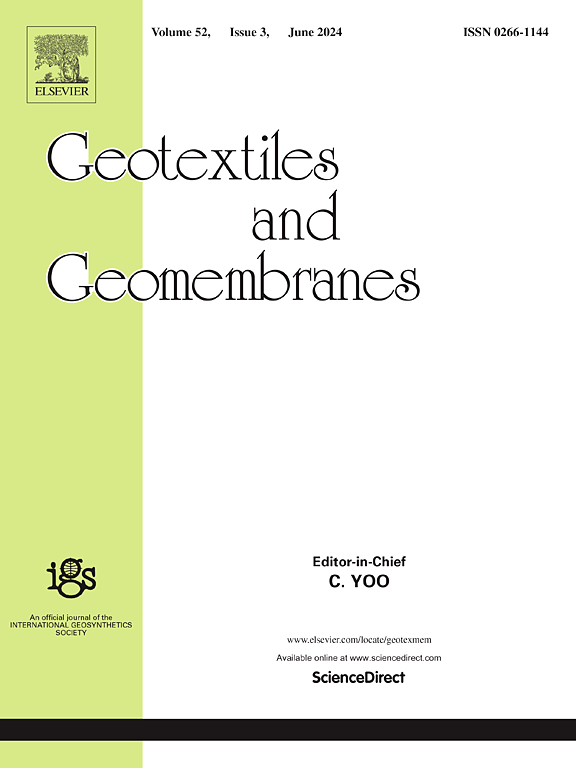土工格栅-砂界面在循环直接剪切作用下的力学行为 DEM 研究
IF 6.2
1区 工程技术
Q1 ENGINEERING, GEOLOGICAL
引用次数: 0
摘要
土工合成材料土壤界面的循环特性对于承受地震荷载的加筋土结构至关重要。为研究土工格栅-砂土界面在循环剪切条件下的力学行为,采用离散元法进行了一系列数值模拟循环剪切试验。结果表明,随着剪切循环次数的增加,致密砂样逐渐收缩,表现出明显的软化特征。在模拟 10 次循环剪切作用下,试样的垂直位移增加了 0.27 毫米,比 1 次循环剪切作用下的垂直位移减少了 0.41 毫米。同时,剪切带出现了明显的扩张。随着循环剪切次数的增加,颗粒发生旋转的区域变化不大,从 75 毫米到 125 毫米不等。样品密度越高,土工格栅-砂界面上的颗粒越难旋转。在相同的循环次数下,密度大的样品剪切带更窄、剪切应变位移更小、剪切刚度更大。砂的粒径为 0.5 毫米,颗粒位移集中在 3 毫米的剪切区。循环剪切完成后,致密砂对未加固砂影响区的孔隙率影响不大,循环周期后的孔隙率接近初始孔隙率。本文章由计算机程序翻译,如有差异,请以英文原文为准。
DEM investigation on mechanical behavior of geogrid-sand interface subjected to cyclic direct shear
The cyclic properties of geosynthetic soil interface are crucial for reinforced soil structures subject to seismic loading. To investigate the mechanical geogrid-sand interface behavior under cyclic shear conditions, a series of numerical simulation cyclic shear tests were conducted using the discrete element method. The results revealed with increasing of shear cycles, dense sand sample gradually shrunk, exhibiting obvious softening characteristics. The vertical displacement of the sample under simulated 10 cyclic shear increases by 0.27 mm, which is 0.41 mm lower than that under 1 cyclic shear. Meanwhile, obvious dilation was observed in the shear band. As the number of cyclic shear increases, the region where the particle rotation occurs does not change significantly, ranging from 75 mm to 125 mm. Higher sample density made it more difficult for particles at geogrid-sand interface to rotate. Under the same number of cycles, denser samples had narrower shear bands, smaller shear strain shifts, and larger shear stiffness. The sand size is 0.5 mm, and the particle displacement concentrated in the 3 mm shear zone. After the completion of cyclic shear, dense sand had little effect on the porosity of the unreinforced sand affected zone, and the porosity after cyclic cycle was close to the initial porosity.
求助全文
通过发布文献求助,成功后即可免费获取论文全文。
去求助
来源期刊

Geotextiles and Geomembranes
地学-地球科学综合
CiteScore
9.50
自引率
21.20%
发文量
111
审稿时长
59 days
期刊介绍:
The range of products and their applications has expanded rapidly over the last decade with geotextiles and geomembranes being specified world wide. This rapid growth is paralleled by a virtual explosion of technology. Current reference books and even manufacturers' sponsored publications tend to date very quickly and the need for a vehicle to bring together and discuss the growing body of technology now available has become evident.
Geotextiles and Geomembranes fills this need and provides a forum for the dissemination of information amongst research workers, designers, users and manufacturers. By providing a growing fund of information the journal increases general awareness, prompts further research and assists in the establishment of international codes and regulations.
 求助内容:
求助内容: 应助结果提醒方式:
应助结果提醒方式:


